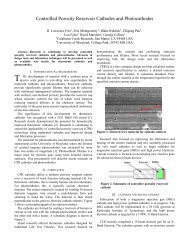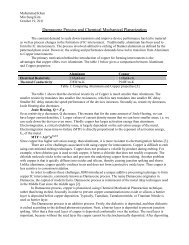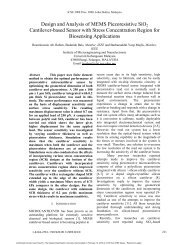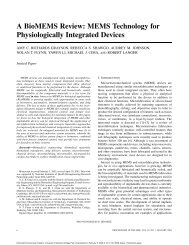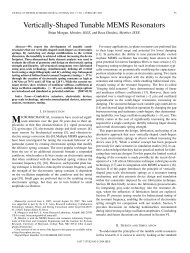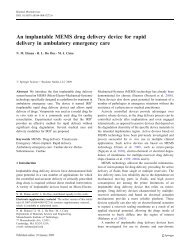Capacity-Equivocation Region of the Gaussian MIMO Wiretap ...
Capacity-Equivocation Region of the Gaussian MIMO Wiretap ...
Capacity-Equivocation Region of the Gaussian MIMO Wiretap ...
Create successful ePaper yourself
Turn your PDF publications into a flip-book with our unique Google optimized e-Paper software.
5702 IEEE TRANSACTIONS ON INFORMATION THEORY, VOL. 58, NO. 9, SEPTEMBER 2012<br />
since 2 is convex by definition, it can be characterized by<br />
solving <strong>the</strong> following optimization problem: 3<br />
(29)<br />
for all , and all possible common<br />
message rates , which is bounded as follows:<br />
(30)<br />
where are <strong>the</strong> single-user capacities for <strong>the</strong> legitimate<br />
user and <strong>the</strong> eavesdropper channels, respectively, i.e.,<br />
(31)<br />
(32)<br />
We note that <strong>the</strong> optimization problem in (29) can be expressed<br />
in <strong>the</strong> following more explicit form:<br />
(33)<br />
(34)<br />
We also consider <strong>the</strong> <strong>Gaussian</strong> rate region which<br />
is defined by (35) at <strong>the</strong> bottom <strong>of</strong> <strong>the</strong> page, where<br />
are given as follows:<br />
(36)<br />
(37)<br />
(38)<br />
(39)<br />
2Although is originally defined for <strong>the</strong> general, not necessarily<br />
aligned, <strong>Gaussian</strong> wiretap channel with public messages, here we use<br />
to denote <strong>the</strong> capacity region <strong>of</strong> <strong>the</strong> aligned <strong>Gaussian</strong> <strong>MIMO</strong> wiretap channel<br />
with public messages as well.<br />
3Although characterizing by solving <strong>the</strong> following optimization<br />
problem:<br />
(28)<br />
for all seems to be more natural, we find working with (29) more<br />
convenient. Here, we characterize by solving (29) for all for all<br />
fixed feasible .<br />
To provide <strong>the</strong> converse pro<strong>of</strong>, i.e., to prove <strong>the</strong> optimality <strong>of</strong><br />
jointly <strong>Gaussian</strong> for <strong>the</strong> optimization problem in<br />
(33)–(34), we will show that<br />
where is defined as<br />
We show (40) in two parts:<br />
1)<br />
2) .<br />
A.<br />
In this case, can be written as<br />
(40)<br />
(41)<br />
(42)<br />
(43)<br />
where we use <strong>the</strong> fact that , and <strong>the</strong> secret message<br />
rate can be given up in favor <strong>of</strong> <strong>the</strong> private message rate<br />
. In o<strong>the</strong>r words, we use <strong>the</strong> fact that when ,<strong>the</strong><br />
maximum <strong>of</strong> is given by ,where<br />
is an achievable public message rate since <strong>the</strong> secret<br />
message can be converted into a public message. This optimization<br />
problem gives us <strong>the</strong> capacity region <strong>of</strong> <strong>the</strong> two-user<br />
<strong>Gaussian</strong> <strong>MIMO</strong> broadcast channel with degraded message sets,<br />
where a common message is sent to both users, and a private<br />
message, on which <strong>the</strong>re is no secrecy constraint, is sent to one<br />
<strong>of</strong> <strong>the</strong> two users [13]. The optimization problem for this case<br />
given in (42)–(43) is solved in [10] by showing <strong>the</strong> optimality<br />
<strong>of</strong> jointly <strong>Gaussian</strong> ,i.e., . This completes<br />
<strong>the</strong> converse pro<strong>of</strong> for <strong>the</strong> case .<br />
B.<br />
In this case, we first study <strong>the</strong> optimization problem in (41).<br />
We rewrite as follows:<br />
(44)<br />
(45)<br />
where we use <strong>the</strong> fact that since , <strong>the</strong> secret message<br />
rate should be set as high as possible to maximize<br />
,i.e.,weshouldset .Let<br />
be <strong>the</strong> maximizer for this optimization problem. The necessary<br />
(35)



